 COVID 19 – Vehicle Stop Procedures during COVID-19
COVID 19 – Vehicle Stop Procedures during COVID-19
Outbreak at Alert Level 2 and Alert Level 3
The health and safety of both our staff and the public is paramount.
Following these instructions when stopping vehicles will reduce the
potential transmission of Covid-19.
This document contains guidance on;
• Alcohol checkpoints in Alert Level 3 & 2;
• Breath Testing Drivers during COVID-19 outbreak - Level 3 & Level 2;
• Sanitising Breath Testing Equipment during COVID-19 outbreak.
Breath Testing Drivers during COVID-19 Outbreak
The breath alcohol screening and testing procedures have been identified as an
area where staff may be at increased risk of infection due to the close
interaction with drivers, handling of breath screening tubes and equipment.
These guidelines are useful to help prevent the spread of infectious diseases,
including COVID-19, during roadside breath testing and evidential breath
testing.
Compulsory Breath Testing – Alert Level 3
Areas that have been placed into
Alert level 3 will not undertake alcohol
checkpoints (impairment prevention operations) as part of reducing the potential
spread of Covid-19 to Police and the community.
Breath screening requires a degree of proximity to another person that we need to
actively limit as part of physical distancing.
Passive breath tests may be conducted, but are not necessary if you suspect the
person has been drinking alcohol prior to driving. In those circumstances you may
immediately require a breath screening test.
Note: Breath testing equipment must be cleaned with an OXIVIR wipe between
each driver tested, in accordance with device sanitising instructions. There must
be a duration of at least one minute between the device being cleaned and the
next test being conducted.
Compulsory Breath Testing – Alert Level 2
At alert level 2 Police may undertake alcohol checkpoints.
Passive breath tests may be conducted, but are not necessary if you suspect the
person has been drinking alcohol prior to driving. In those circumstances you may
immediately require a breath screening test.
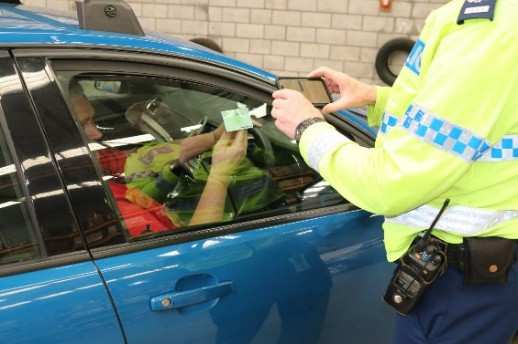 Note:
Note: Breath testing equipment must be cleaned with an OXIVIR wipe between
each driver tested, in accordance with device sanitising instructions. There must
be a duration of at least one minute between the device being cleaned and the
next test being conducted.
TENR Threat Assessment
As part of the TENR threat assessment, staff should consider the risks
associated with engaging with drivers and different types of checks during
vehicle stops and how to mitigate these risks. Example follows;
• Driver licence checks with licence inspected through window,
• Vehicle TWIRL inspections while driver keeps window up,
• Issuing an ION or pink/green sticker,
• Carrying out a roadside evidential test where possible instead of requiring
a driver to accompany to a station in your patrol vehicle, and
• Using a 7510NZ or 6510NZ where only the officer holds the devices
versus a driver holding a 9510NZ tube.
Roadside Process
Staff should apply TENR to all interactions. Maintain a distance of at least 1 metre
from the other person if possible. Take additional precautions if someone presents
as unwell.
As part of their TENR threat assessment staff
must consider all PPE options for
vehicle stops/breath testing, i.e. gloves, mask and eye protection, in
accordance with existing directives on use, to mitigate the threat to staff and
community of transmission of the virus.
Ask the following preliminary questions prior to conducting any check or tests:
• are they feeling well/unwell;
• have they been tested for COVID-19 and received a positive result;
• have they been exposed to a person with COVID-19; and
• have they returned from overseas in the past 14 days?
For example if a driver indicates they are sick
(with coronavirus symptoms1), you can advise
them to keep their window up while checks are
being completed.
Apply TENR when deciding whether to use
gloves. Particular consideration should be given
when handling property from or to a driver.
Gloves can transfer contagions, so avoid
touching your face or getting back into your
vehicle while still wearing the gloves.
Wash your hands with soap and water or use hand sanitiser following each
vehicle stop completed without wearing gloves, or otherwise after removing
and disposing of gloves. Avoid touching your face until after washing or
sanitising your hands.
1 Symptoms include: a cough, a high temperature of at least 38°C, shortness of
breath, sore throat, sneezing and runny nose, temporary loss of smell.

If undertaking a task requiring the wearing of gloves across different contacts,
the gloves should be sanitised between each contact. In the case of drink driving
checkpoints, the gloves can be sanitised with an OXIVIR wipe between each
person tested, at the same time as the breath testing device is sanitised.
All PPE is to be disposed of as a biohazardous substance.
PPE requirements - what you need in your vehicle
• Hand sanitiser with an alcohol content between 60-95% is recommended.
Do not use prior to breath testing a driver
• Disposable gloves and a rubbish bag
• OXIVIR ready-to-use wipe stored in an airtight bag for cleaning your car
and Dräger breath testing device
• Sanitised Dräger breath testing device.
Caring for breath testing devices
Breath testing devices are sensitive to alcohol. Alcohol based products
must not
be used on or stored near these devices.
Refer to
Sanitising Breath Testing Equipment during COVID-19 Outbreak
for sanitising procedures post driver processing.
Breath testing
NOTE: Always carry out a clean air screening test before asking the driver to
complete a passive breath test or otherwise provide a breath specimen with a
Dräger 7510NZ or 6510NZ. This ensures that the previous device sanitising
procedure has been carried out correctly and that the air intake is not
blocked with the cleaning solution.
Ensure you have followed PPE
guidelines before conducting breath
testing procedures with as much of
your body as reasonably possible away
from the driver’s line of breath, and
avoiding contact with the vehicle.
Note: due to the risks associated with
breath testing always wear gloves as a
minimum.

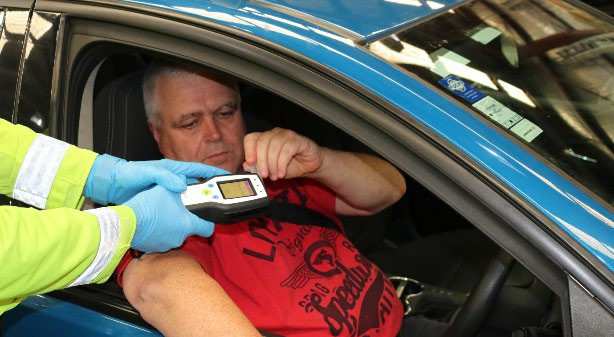
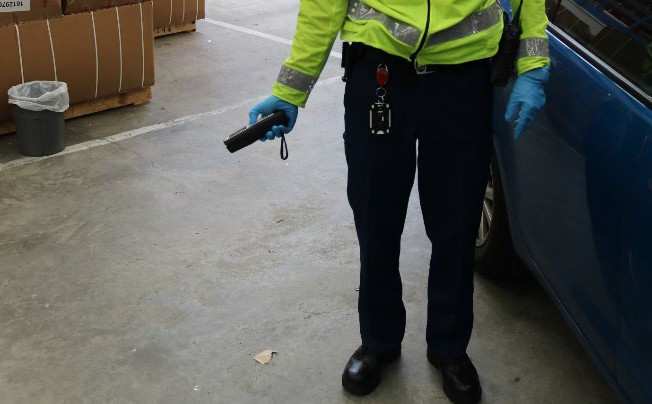
Upon obtaining a result, always
point the device away from
you/your vehicle and equipment
while it automatically purges.
Always consider the wind direction.
Note: The 9510NZ will purge from the
rear of the device after a test – consider
your position and surrounding
equipment prior to initiating a breath
test.
Passive Breath Test
Advise the driver to maintain the same body position, stay in the vehicle, and
talk straight ahead towards the device, i.e. not out the window towards you.
Breath Screening or Evidential test
Advise the driver to maintain the same
body position for a screening or evidential
test, stay in the vehicle, and blow straight
ahead, i.e. not out the window towards
you.
Upon completion of the test the officer
should, with a gloved hand, use the
removal slider on the side of the 7510NZ
to remove the mouthpiece, or simply lift
off the mouthpiece by hand for a
6510NZ.
NOTE: Safe disposal of the mouthpiece can be achieved by removing the tube
with a gloved hand and then immediately pulling the glove off over the tube
whilst ensuring the tube remains inside the glove. The glove and tube should be
disposed of as a biohazardous substance.
Note: The 9510NZ mouthpiece can be removed by the officer and
disposed of as a biohazardous substance.
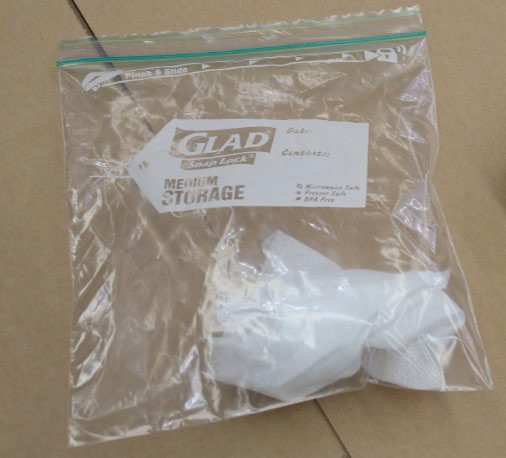

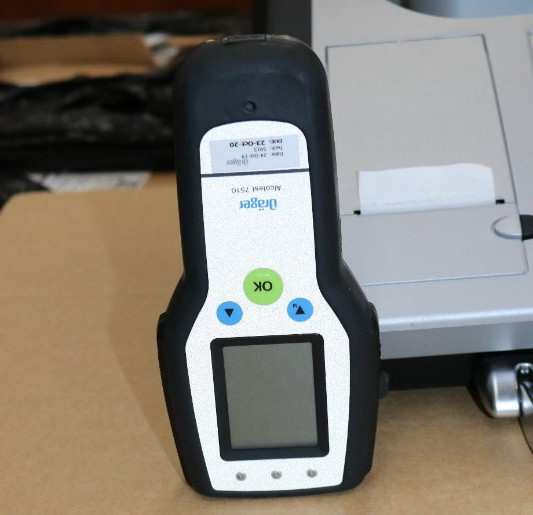
Upon conducting any test, always point the device away from you (and the
9510NZ outlet) from you/your vehicle & equipment while it automatically
purges. Always consider the wind direction.
Sanitising Breath Testing Equipment during COVID-19 Outbreak
Ensure you have the following to complete sanitising of a breath
testing device; Oxivir wipe in airtight bag that is still ‘wet’ – THIS IS
A
REUSEABLE PRODUCT.
Oxivir spray surface cleaner for EBA rooms or
mobile road safety bus surfaces, and
PPE gear including disposal equipment.
OXIVIR ready-to-use wipe stored in airtight bag.
Cleaning Dräger 7510NZ and 6510NZ Breath Testing devices
Wipe your PPE gloves with the OXIVIR ready-to-use wipe so the entire surface is
wet before picking up the Dräger device.
Wipe the entire exterior of the 7510NZ or 6510NZ with an OXIVIR ready-to-
use wipe so it appears wet.
Place or hold the 7510NZ or 6510NZ upside
down for a minimum of 1 minute for sanitising
to occur, and to ensure any sanitiser in the ‘air
intake nipple’ has cleared.
If not immediately using the device after the
cleaning procedure has been completed, place
it in an airtight bag marked ‘CLEAN - ready for
use’. This bag can be reused if the device is
sanitised each time.
• Place the OXIVIR ready-to-use wipe
back in an air-tight bag for re-use.
• Dispose of your PPE equipment as
per existing procedures.
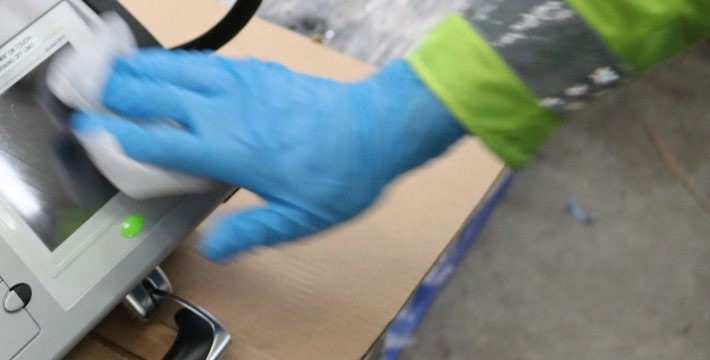
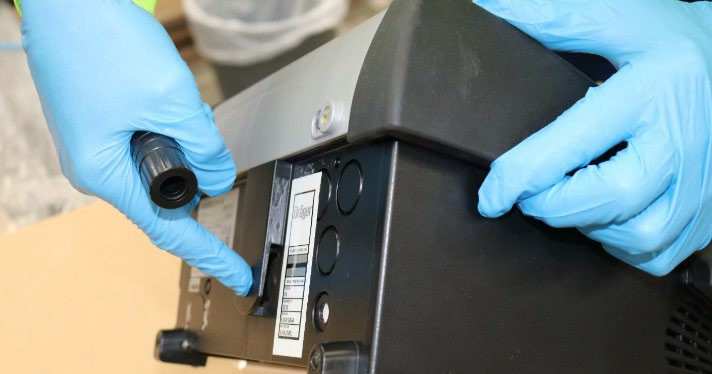
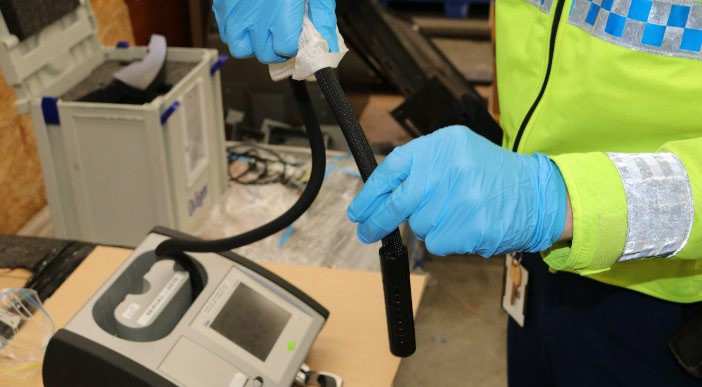
 Cleaning Dräger 9510NZ Breath Testing devices
Cleaning Dräger 9510NZ Breath Testing devices
Wipe the entire exterior of the
9510NZ so it appears wet ensuring
the hose is loose to one side.
Note some devices are permanently
screwed to desks so you will not be
able to sanitise the underside.
Wipe around/under the edge of the
9510NZ purge port at the rear
[pointed to in picture].
NOTE: Be aware of the purge
outlet and your location during
driver breath testing.
Next wipe the entire hose starting
at the machine and working
towards the mouthpiece section.
NOTE: do pull or stretch the
hose as it contains a heating
element.
Wipe the down the mouthpiece
attachment.
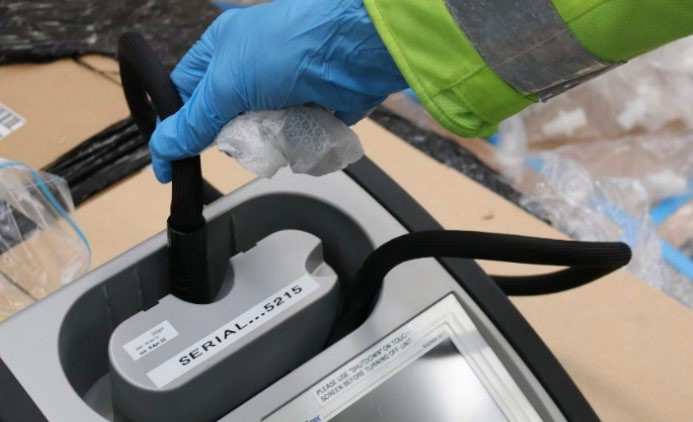
Last place the hose back in the
holder vertically to allow any
sanitiser to clear.
Sanitise any surrounding walls, tables etc., with OXIVIR Spray cleaning
product.
Allow the 9510NZ a minimum of 1 minute of air-drying for sanitising to occur
before reuse.
• Place the OXIVIR back in an air-tight bag for re-use.
• Dispose of your PPE and cleaning products as per existing procedures.
NOTE: CREW sanitiser CANNOT be used on the Dräger breath testing devices.
Further Information
Staff who have health concerns in relation to COVID-19 are encouraged to
seek medical advice from their GP or 0800 POL INFO.
People & Capability offer a helpline for staff and whanau - call 0800 POL-
INFO (0800 765 4636) if you need urgent advice.
This remains a fluid situation. For the latest information and advice please
check the Coronavirus Ten One intranet page.
 Attending a known COVID-19 address
Attending a known COVID-19 address
This remains a fluid situation, for the latest information and advice please check our Ten One intranet
page.
A process is in place for the Ministry of Health to notify Police of confirmed COVID-19 cases. Police may
also become aware of an address where people are suspected of having COVID-19 but have not yet
been formally diagnosed.
If Police need to attend an address where COVID-19 is either confirmed or reasonably likely, follow
the guidance below.
Notification process
Confirmed COVID-19 cases will have a Comms Centre special alert attached to the address.
The Comms dispatcher will advise the local District Command Centre and also advise the
deployed unit to contact their District Command Centre prior to deploying to the address.
The Comms shift commander and District Command Centre will discuss whether attendance is
necessary, or an alternative means of Police contact would be more appropriate in the
circumstances of the request for service such as phone, Facetime or WEBEX.
The deployed unit will then contact (via mobility device – DO NOT USE RADIO) their local
District Command Centre where they will receive any additional information required and
directions on the appropriate Health and Safety protocols.
Police staff should not deploy to any call for service to a COVID-19 special alert
address without contact being made with the District Command Centre first.
Attending the address
Staff should check their vehicles are stocked with the appropriate PPE prior to starting their
shifts and prior going to the address.
Refer to the PPE Guidelines for guidance on putting on
and taking off masks.
Prior to attending the address, staff should assess what activity they will likely be carrying out.
Police staff will continue to utilise TENR as their primary risk management tool to determine their
appropriate actions at the address upon arrival.
Avoid entering the address and maintain your distance from the occupants if possible. If this is
not possible, apply the correct level of PPE.
The attending officers are to ensure they are following the recommended procedures for the use
of Personal Protective Equipment (PPE) as per the
PPE Guidelines.
If you have to be in close contact with someone who is actively unwell, ask them to put on a
surgical mask to minimise the spread of droplets in the air from the person coughing or sneezing.
If attending the address due to a notification of non-compliance with self-isolation, seek advice
from Regional Public Health and the local Medical Officer of Health. Be aware – Police cannot
detain a person for non- compliance unless directed to do so by a properly authorised Medical
Officer of Health. More information is available on the Checkpoint mobility app in the Operational
section.
1
Taking a suspected COVID-19 case into custody
In the event a known or suspected COVID-19 patient has to be removed from the address
and taken into custody, try and get the person to put on a surgical mask prior to getting into
the car.
If the person is taken into custody and it is believed they could be infected by COVID-19 a
surgical mask should be applied.
(Reasonable force could be used with a non-compliant prisoner
– this is similar to applying handcuffs – it is a protection measure for our staff)
Officers may have to continue to wear full PPE during the drive to the custody unit.
Alert the custody unit of the situation prior to your arrival so they can prepare.
Once the detainee has been handed over to custody, isolate the transporting vehicle and follow
the
COVID-19 Cleaning Protocol available on Ten One.
Before leaving the address
Unless transporting a COVID-19 patient, all PPE (such as masks and gloves) must be removed
and placed into a rubbish bag prior to getting into the car.
See the PPE Guidelines for guidance
on removing masks.
After removing PPE, apply hand sanitiser. Avoid touching your face until after sanitising
your hands. (Protective goggles can be sterilised/cleaned and reused)
The rubbish bag should be sealed, and disposed of upon arriving back at the station. Stations
should have a process in place for disposing of this waste appropriately.
Once back at the station, or at your first opportunity, wash hands thoroughly with soap and
warm water and dry thoroughly.
2
 Police Building Procedures during L2 COVID-19
Police Building Procedures during L2 COVID-19
Under Level 2, most of our staff can return to work if they can do so safely. This document
outlines the protocols to be followed at Police buildings to achieve that aim.
Entry Requirements
Before entering a Police building a person should not have:
A high temperature (at least 38°C)
A cough
(Unexpected) breathlessness
Sneezing and runny nose
Temporary loss of smell
Had close contact with a known or suspected COVID-19 case
Returned from overseas travel in the last 14 days
If any of the above conditions apply a person should not enter the building unless they are being taken
into custody, when the ‘COVID-19 - Police Custody High Level Standard Operating Procedures’ applies.
Workstations
Desks should be spaced to ensure at least 1m physical distancing if possible. Where 1m distancing is
not possible physical barriers such as divider panels or Perspex screens should be considered. Where
this is not possible then a face mask should be worn.
Reduce the clutter on personal desks as far as possible. Every object on your desk is capable of
harbouring COVID-19; the fewer objects, the lower your risk.
All workstations (personal and hot desks) should be cleaned* before and after use. Once you have
cleaned a workstation, ensure a
CLEAN sign is visible. When you start using a workstation, change the
sign to
DIRTY.
Clean your hands before and after using a hot desk, after using common equipment such as
copiers, and frequently during the shift.
At the end of your shift please ensure all personal items are removed from hot desks, ensuring only
computers, phone, and peripherals remain.
Meetings and common areas
Online meetings should be the first choice.
Physical distancing, hand hygiene, and cough etiquette should be practiced.
Meeting rooms should be cleaned* before and after use. Once you have cleaned a meeting room,
ensure a
CLEAN sign is visible. When you start using a meeting room, change the sign to
DIRTY.
Restrict people in meeting rooms to maintain adequate physical distancing where possible.
Only take items required for the meeting into the meeting room. Once the meeting is over, remove
any items you took in.
To reduce the risk of transmission, people should limit their travel between areas of buildings. Only use
areas which are required for your role. Limit travel between floors and other locations/stations to
necessary travel only; use the phone or Webex where possible.
District gyms in stations may be opened. Local procedures to keep gyms clean and limit numbers are
required (stay 1m apart if possible) and contact tracing of those using the gym is also required.
Kitchen use
Clean your hands before and after using kitchen areas.
Common cutlery and crockery should be washed before and after use.
Cafes in Police premises can reopen but must comply with Government requirements for Level 2.
Increased cleaning of hard surfaces should remain in place along with hand hygiene practices and
physical distancing.
Contact Tracing
It is important to have a record of who each person had close contact with each day to allow tracking
of possible contacts if COVID-19 cases are suspected or confirmed. A close contact is someone who
has had face-to-face contact in a closed environment within 2 metres for 15 minutes or more.
Police locations have a Simple Trace QR code which is to be scanned by mobile phone camera to
Check-in and
Check-out. There may be more than one QR code per building or floor so multiple
scans may be required. For staff without a mobile phone the QR code posters contain details of how
you can Check-in and Check-out using a web browser.
Police phones also have the Ministry of Health (MoH) NZ COVID Tracer App. This App should be used
when visiting locations outside of Police buildings that have the MoH QR code displayed. The NZ
COVID Tracer App can also be downloaded on your personal phone from the App store.
Everyone is to record the details of people from whom they have been unable to maintain
2m physical
distancing. Where work teams share a common work space this may require recording work team
members present each day and recording of meeting attendees. This record may be written notes,
photos of who was at meetings, or similar as long as all close contacts can be traced if required.
Trial Fire Evacuations
Trial emergency evacuations can take place at Level 2. If you hear the fire alarm, follow normal
emergency procedures.
*Cleaning
Cleaning of rooms and workstations means using Oxivir and a disposable cloth to wipe down any hard
surfaces. For workstations, don’t forget phones and peripherals. For meeting rooms, don’t forget
whiteboard pens and dusters.
CLEAN
This desk or room is clean and ready for use
DIRTY
This desk or room is dirty and should be cleaned prior to use
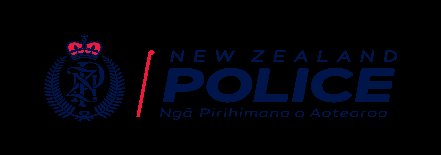 Police Custody Operating Procedures for COVID-19
v1.7
Police Custody Operating Procedures for COVID-19
v1.7
Section 9(2)(a) Official Information Act
1982
Section 9(2)(a)
Section 9(2)(a) Official
Official Information
Information Act 1982
Secti
Act
1982
on
9(2)
(a)
Offici
al
Infor
matio
n Act
1982
Section 9(2)
Section 9(2)(a) Official
(a)
Official
Information Act 1982
Information
Act 1982
COVID-19 - Police Custody Operating Procedures - August 2020
Page 1
link to page 16 link to page 18 link to page 18 link to page 18 link to page 19 link to page 21 link to page 21 link to page 22 link to page 23 link to page 24 link to page 25 link to page 26 link to page 27 link to page 28 link to page 28 link to page 29 link to page 30 link to page 31 link to page 32 link to page 34 link to page 35 link to page 38
Contents
High Level Overview ................................................................................................... 3
Key changes for Police Custody ................................................................................. 5
Key considerations for managed isolation (all levels) ............................................. 5
Key considerations for alert level 1 & 2 .................................................................. 5
Key changes at alert level 3 and 4 ......................................................................... 6
Where to get more information ................................................................................... 8
Quick links .............................................................................................................. 8
Confirm decision to hold in Custody ........................................................................... 9
Transfer to Custody Unit ........................................................................................... 10
Receive detainee in Custody Unit ............................................................................. 11
Care for person in custody........................................................................................ 12
Transfer to Oranga Tamariki ..................................................................................... 13
Transfer to Mental Health ......................................................................................... 14
Court Appearance .................................................................................................... 15
Appearance in person .......................................................................................... 15
Instructions for management of court cells ............................................................... 16
Transfer to Corrections ............................................................................................. 17
Safe detainee/prisoner transport protocols ............................................................... 18
Safe cleaning protocols ............................................................................................ 19
Glossary ................................................................................................................... 21
Appendix A: Regional Public Health Contacts .......................................................... 22
Appendix B: Guide to assessing the risk of COVID-19 ............................................. 25
COVID-19 - Police Custody Operating Procedures - August 2020
Page 2
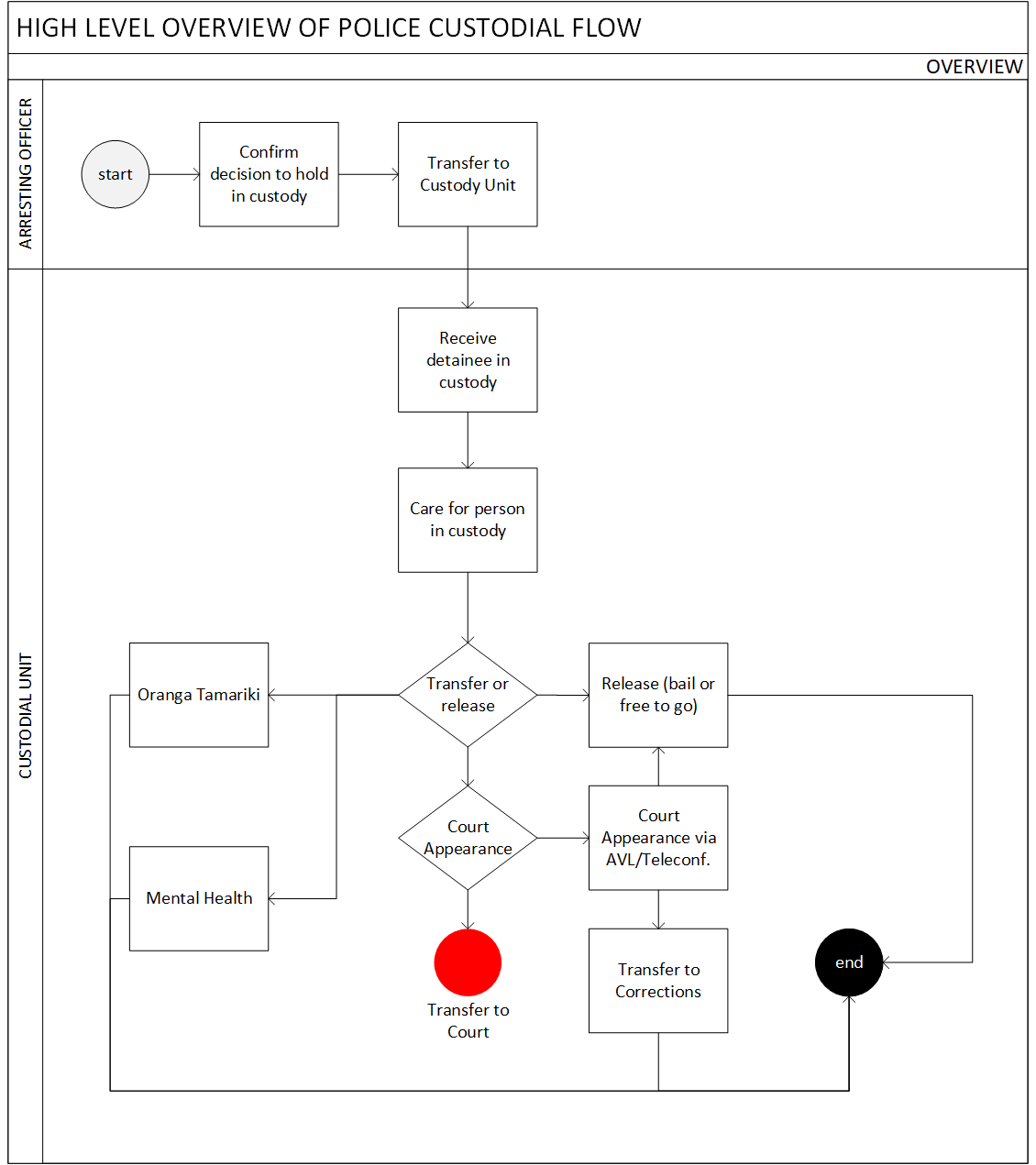 High Level Overview
High Level Overview
The diagram below is a high level overview of the Police Custodial Process.
COVID-19 - Police Custody Operating Procedures - August 2020
Page 3
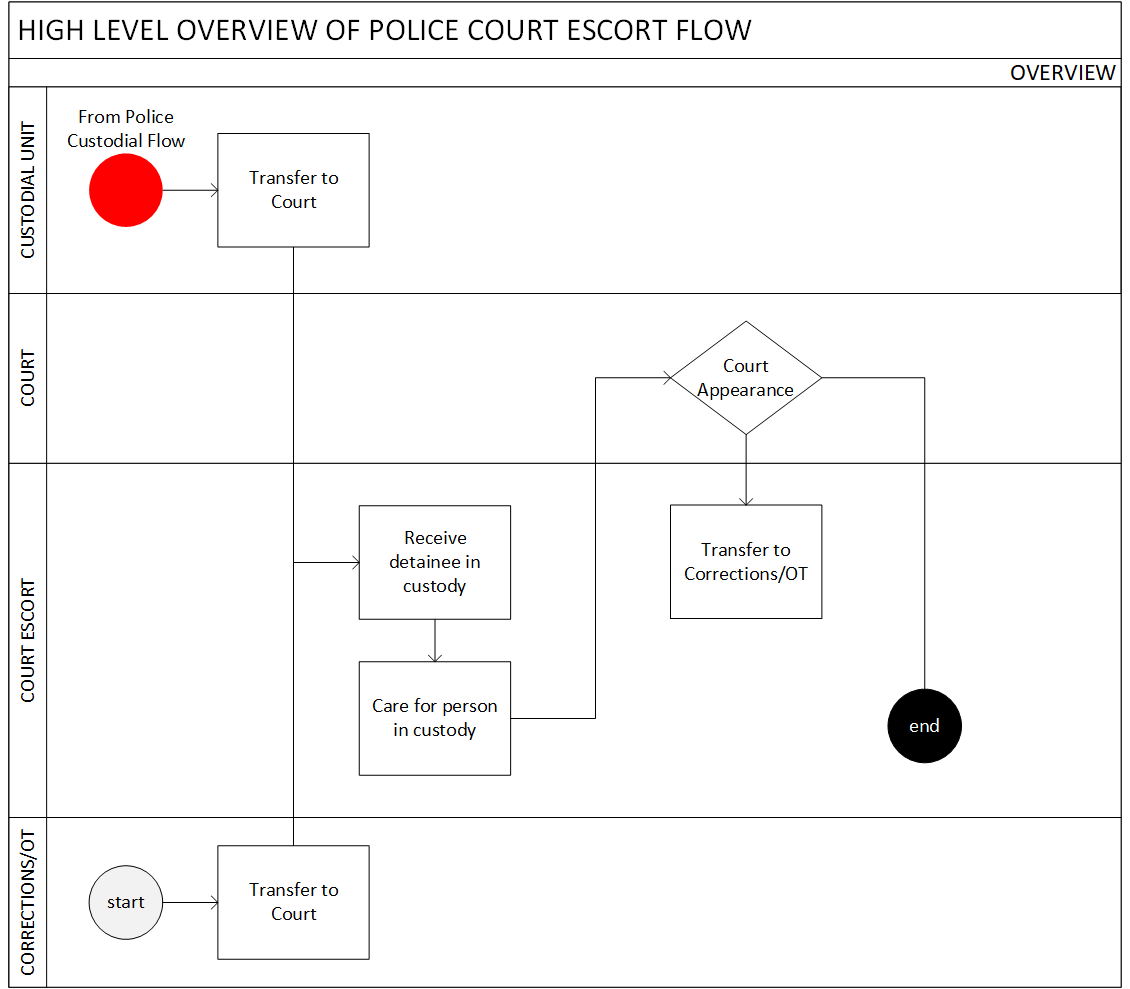
The diagram below is a high level overview of the Police Court Escort Process.
The key steps for each process are described in the sections below.
COVID-19 - Police Custody Operating Procedures - August 2020
Page 4
Key changes for Police Custody
Key considerations for managed isolation (all levels)
• Section 8(h) of th
e COVID-19 Public Health Response (Air Border) Order 2020
allows for persons being held in quarantine at the border to be taken into
custody or appear in court.
• Al detainees being brought into custody who would otherwise be in managed
isolation under this order must be treated as suspected COVID carriers. This
means:
o Arresting officers must notify the custody unit that they are bringing in a
detainee who is under quarantine prior to arrival at the custody unit;
o Al staff must wear full PPE at all times when dealing with the detainee;
o The number of persons interacting with the detainee must be kept to a
minimum;
o The detainee must be held in single-occupancy;
o Al areas where the detainee is held and any surfaces touched by the
detainee must be cleaned according to the level
4 cleaning protocols;
o The detainee must travel in isolated transportation (eg by themselves or
alone in a pod);
o Partner agencies must be informed of the detainees quarantine status
prior to transfer and an electronic record of the notification must be kept;
o The detainee must be kept separate from Corrections detainees in the
court cells and Corrections must be informed of any potential contact
between a Corrections prisoner and a detainee who is under quarantine.
Key considerations for alert level 1 & 2
• Police Custody staff who are unwell should not go to work. Refer to MOH
guidelines at
keeping safe
• Alert level 1 & 2 is likely to see a sustained increase in Police custodies and
court appearances as more Courts schedule increased hearings to deal with
the backlog and as more businesses reopen and restrictions on movements
and activities are further reduced. Custodial units should be prepared for pre-
COVID levels of offending and custody.
• Physical distancing is required under AL2 for detainees in cells and detainee
movements.
•
Court protocols for alert level 2 have been published. Al defendants who are
in police custody or corrections custody wil appear in person for all scheduled
appearances during the Alert Level 2 period, unless directed to appear by
AVL.
• PPE for custody of all detainees is based on staff risk assessment. S
ee PPE
Requirements
• Contact tracing records for detainees in shared cells is only mandatory from
AL2.
• The Handover Form for AL1 & AL2 can be located
here.
COVID-19 - Police Custody Operating Procedures - August 2020
Page 5
link to page 38
• Cleaning in custody units in both police facilities and courts are normal
protocols with the exception that at AL2, cleaning should occur after a
symptomatic person has been in the cells.
• The “Guide to assessing the risk of COVID-19”
(appendix to this document)
remains a useful guide for the initial custody unit’s assessment of all detainees
being received into the custody unit. The custody assessment wil guide the
requirements for PPE.
• A COVID bail assessment of all detainees being released prior to allowing bail
is not required under AL1 & AL2. Bail processes are as per BAU normal.
• Custody Units should operate a contact tracing register for visitors to
detainees.
• In AL1 there is stil a need for vigilance. Good hygiene, is stil expected.
Custody Units have an important role to play in ensuring all those involved in
the custodial process are safe.
Key changes at alert level 3 and 4
The key changes for Police Custody as a result of moving to Alert Level 3 or Alert
Level 4:
• Any transfer to custody unit must have approval prior to arrival (see Confirm
decision to hold in custody section below).
• Al constabulary staff have been issue
d Personal Protection Equipment (PPE)
and this must be used in accordance with this guidance.
• The Justice Sector has introduced
a Handover Form that must be used when
transferring prisoners between agencies – so information is shared in a
consistent format.
This form must be completed and given to the receiving
agency when transferring detainees.
• Al persons in Police custody who have COVID-19 symptoms (or other
COVID-19 risk factors) must be held in sole occupancy cells and kept isolated.
• Ministry of Justice may require identification be produced by all persons
(including Police) in order to gain entry to the court for contact tracing
purposes.
• Court cells under Police Custodial Management must comply with this SOP.
This includes the following sections:
o “Receive detainee in Custody Unit; and
o “Care for person in custody”
Where Ministry of Justice, Judiciary or any other persons raise issues or
concerns about the application of these SOPs, the matter should be reported
immediately to the District Custody Manager.
Court Escort staff are not permitted to change COVID 19 processes
described in this SOP.
COVID-19 - Police Custody Operating Procedures - August 2020
Page 6
• For emergency accommodation for bailee under AL3 within Tāmaki Makaurau
boundaries, Corrections wil provide emergency accommodation for the
weekend of 15 and 16 August. Section 9(2)(a) Official Information Act 1982
• For emergency accommodation for bailee under AL3 outside of Tāmaki
Makaurau boundaries, but only in Northland and Waikato Districts, MSD wil
provide emergency accommodation for the weekend of 15 and 16 August. To
access this service staff are to contact their DCC and follow the PSO
accommodation process.
Considerations for youth:
• AVL appearances are no longer the default position, although there wil be
circumstances that may necessitate the use of AVL. Appearance in-person
remains the default position. The number of in-person appearances made by
young people wil increase for monitoring events and other substantive
hearings.
• Young People who have been arrested and are in Police Custody i) Young
persons who are arrested are to be brought before a Youth Court in person for
consideration of bail. Under Level 1, the young person is to be brought to the
nearest courthouse which is open and operating. An application may be made
to a Judge for such an appearance of the young person to be by AVL where
appearance in person is not practicable.
COVID-19 - Police Custody Operating Procedures - August 2020
Page 7
Where to get more information
Custodial staff should consult the
Operational Instructions on Ten-One for more
information.
Quick links
Below are some useful links:
Bail – Release from Custody: Word/Police Forms A-H/COVID 19/ – the form to be
used when releasing on bail, available from Police Forms.
Bail process flow chart – describes how to decide whether to use normal bail process
or the alert level 4 bail process.
COVID-19 Public Health Response (Air Border) Order 2020 – legislation relating to
the managed isolation of persons entering New Zealand from other jurisdictions.
Court Protocol at Alert Level 1 – court protocols published by MOJ for alert level 1
Custody Unit minimum PPE requirements – the minimum requirements for the use of
PPE in Custody.
Handover Form – to be used when transferring detained persons between agencies
(eg Corrections or Oranga Tamariki).
Healthline: 0800 358 5453 – the number to be called when a detained person is a
suspected COVID-19 carrier.
Health Ministry of –
Protecting yourself and others from COVID-19
Ministry of Social Development (MSD) where to go for services and support (0800
559 009) – website and phone number to use when requesting support from MSD.
Personal Protection Equipment (PPE) - An introduction to Police PPE equipment.
Ten One PCWs – an overview on issuing formal warnings.
COVID-19 - Police Custody Operating Procedures - August 2020
Page 8
Confirm decision to hold in Custody
1. Consider the following options:
• Warnings – note that PCWs and Formal Warnings can now be issued in
the field
(Ten One PCWs).
• Release from police custody following service of summons – use this
option for any defendants who do not fall into the two categories below (ie:
Police Bail or Hold in Custody).
• Release from police custody on police bail – use this option for those
defendants:
o whose bail is not opposed, but bail conditions are necessary to
sufficiently mitigate a risk to a victim and/or other person or of re-
offending, or
o who are charged with breaching a protection order, but are not within
the 24-hour period immediately following their arrest.
• Hold in custody to appear in an arrest court – this option should be used for
those defendants:
o whose bail is opposed due to a risk to a victim and/or other person, or
of re-offending, that cannot be sufficiently mitigated by bail conditions,
or
o whose bail is restricted under the Bail Act 2000, whether or not their
bail is opposed by Police, or
o who are charged with breaching a protection order and they are stil
within the 24-hour period immediately following their arrest.
2. Obtain approval to take into custody from the DCU prior to arrival at the DCU.
COVID-19 - Police Custody Operating Procedures - August 2020
Page 9
Transfer to Custody Unit
For all detainees
1. Consider
all appropriate options before deciding to take any person into
custody, such as Alternate Resolutions, Formal Warnings, or Summons
2. Consider appropriate PPE based on risk assessment before leaving the
vehicle.
3. Preferably maintain social distance from any other person if possible. Assess
detainee for COVID-19 Symptoms or risk factors during arrest.
4. Safely dispose of all used consumables.
5. If necessary, clean according t
o agreed cleaning standards on Ten One.
Detainee with COVID symptoms or risk factors
6. Offer detainee gloves and masks if appropriate.
7. Use spit hood if required.
8. Inform Custody unit that the detainee has COVID-19 symptoms or risk factors
before arrival, so they can prepare.
9. Sanitise PPE and replace gloves and masks before returning to duty.
COVID-19 - Police Custody Operating Procedures - August 2020
Page 10
link to page 38
Receive detainee in Custody Unit
For all detainees
1. PPE is not necessary where there are no symptoms or indicators of a COVID
risk.
2. Wear full PPE when dealing with a detainee whose COVID risk has been
assessed (by the Custody Unit) and is not low.
3. Use the Guide for assessing the risk of COVID-19 i
n Appendix B of this
document to determine the COVID-19 risk of a detainee. Do not rely on the
assessment made by the arresting officer.
4. After assessing detainee for COVID-19 symptoms or risk factors (see
Appendix B: Guide to assessing the risk of COVID-19) note the evaluation on
the Electronic Custody Module (ECM).
5. Custody Supervisor to consider rationale for arrest before deciding to accept
any person into custody.
6. Safely dispose of all consumables used by a detainee.
7. Where no risk of COVID is evident, process detainee as per normal procedure
Detainee with COVID symptoms or risk factors
8. Clean any holding, interview, statement room, hygiene area, biometric data or
search area after use according t
o agreed cleaning standards on Ten One
9. Sanitise PPE and replace gloves and masks before processing the next
person.
10. Use spit hood if required.
11. Place in an isolation cel as sole occupant (this is mandatory for any detainee
with COVID-19 symptoms or risk factors).
12. Ensure property is placed in plastic bag and sealed. Clearly mark as COVID
risk and disinfect outside of bag when sealed.
13. Ensure the cell is clearly identified as a COVID-19 isolation cell for all staff
working in the Custody Unit.
14. Contact Healthline 0800 358 5453 or your Regional Public Health team to
advise of potential presence of COVID-19.
COVID-19 - Police Custody Operating Procedures - August 2020
Page 11
Care for person in custody
For all detainees
1. Apply sensible social distancing when possible. Continue all existing BAU
processes around care and monitoring, meals, and personal hygiene.
2. .Visiting can be allowed as per normal procedures. Maintain a contact tracing
register for visitors.
3. Al visitors are to be fully briefed on hazards and required protocols prior to
entry.
4. Al visit are to be recorded in the ECM Note any COVID-19 related concerns
on the ECM and contact Healthline 0800 358 5453 or your Regional Public
Health team to advise of any potential presence of COVID-19.
Detainee with COVID symptoms or risk factors
5. Place detainee on the existing frequent or constant monitoring regime as
appropriate,
6. Call an ambulance if there is imminent risk to life (eg detainee has trouble
breathing).
7. Tell detainee to use hand sanitiser, gloves and masks (if sufficient stock
available) when moving around the Custody Unit.
8. Use spit hood when moving detainee around the Custody Unit if required.
9. Clean any interview room, or other area occupied by the detainee, ablution
areas after use according to “Safe cleaning protocols” in this document.
COVID-19 - Police Custody Operating Procedures - August 2020
Page 12
Transfer to Oranga Tamariki
For all detainees
1. Provide a completed
Handover Form via email and hardcopy. Make sure the
email is stored for future records.
Detainee with COVID symptoms or risk factors
2. Tell detainee to use hand sanitiser, gloves and masks (if sufficient stock
available) during transport.
COVID-19 - Police Custody Operating Procedures - August 2020
Page 13
Transfer to Mental Health
For all detainees
1. Provide a completed
Handover Form via email and hardcopy. Make sure the
email is stored for future records.
2. Follow existing protocols
Detainee with COVID symptoms or risk factors
3. Tell detainee to use hand sanitiser, gloves and masks (if sufficient stock
available) during transport.
COVID-19 - Police Custody Operating Procedures - August 2020
Page 14
Court Appearance
For all detainees
1. Subject to the Courts (Remote Participation) Act, all defendants in
police
custody are to appear in person unless a Judge otherwise directs that the
appearance be by way of AVL.
2. Wear appropriate PPE as required on a risk assessment basis. If there is no
indicated risk, PPE is not required. In the Court custodial setting, Corrections,
Justice and Police can now operate on a 'risk-based' use of PPE, i.e. PPE not
required unless deemed necessary by staff. However, note that if one of the
three agencies in a shared location decides there is a risk and uses PPE, then
all personnel in that location are to use PPE at that higher level.
3. Provide a completed
Handover Form to Courts and court cell O/C via email
and hardcopy so they are aware of any risk related to the detainee. Make sure
the emails are stored for future records, (and matching with close contact
tracing records).
Appearance in person
4. Ensure identification for all staff and defendants can be provided on arrival at
court (Ministry of Justice may require identification be produced in order to
gain entry to the court for contact tracing purposes).
COVID-19 - Police Custody Operating Procedures - August 2020
Page 15
Instructions for management of court cel s
1. Follow your existing in person Court appearance custodial process and in
addition apply all COVID safety protocols required for the district custody unit
as described in this SOP.
COVID-19 - Police Custody Operating Procedures - August 2020
Page 16
Transfer to Corrections
For all detainees
1. Follow normal procedures. PPE is only required when a risk assessment
indicates a possibility of COVID infection. Provide a complet
ed Handover
Form to Corrections for each detainee, via email and hardcopy. Make sure the
email is stored for future records.
Detainee with COVID symptoms or risk factors
2. Tell detainee to use hand sanitiser, gloves and masks (if sufficient stock
available) during transport.
3. Consider using spit hood if required.
4. Transport according to the “Safe detainee/prisoner transport protocols” in this
document.
COVID-19 - Police Custody Operating Procedures - August 2020
Page 17
Safe detainee/prisoner transport protocols
Note: these protocols relate to the transport of COVID suspected detainees in Police
vehicles. Safe transport and accommodation must be considered prior to any
transport.
For all detainees
1. Always use prisoner transport van if available.
2. Transport in isolation where possible.
3. Transport all vulnerable detainees or prisoners (elderly or compromised
immunity) in isolation.
Detainee with COVID symptoms or risk factors
4. Prisoner transport strongly recommended.
5. Do not transport in an I-car with other detainees unless absolutely necessary
for the maintenance of the law and prevention of harm.
COVID-19 - Police Custody Operating Procedures - August 2020
Page 18
Safe cleaning protocols
Where a Police employee does need to undertake cleaning it must be done in
accordance with th
e agreed cleaning standards on Ten One for general cleaning.
For Custody Units
The following protocol provides information on cleaning of equipment, area or space
(including vehicles) that have been occupied / used by a person confirmed to have or
suspected of having COVID-19.
This protocol applies after the person has finished using the equipment, area or
space (including vehicles); and before another person uses the space.
Where cells and vehicles are to be cleaned according to this protocol, the preference
is for this to be carried out by the contract cleaner. If this is not possible, it can be
carried out by staff so long as staff have the PPE, training, knowledge and
information to carry out the job safely.
Prior to cleaning
• Ensure a stand-down period of at least 20 minutes before cleaning the space.
• Personal protective equipment (PPE): wear a disposable facemask, gown or
disposable overalls and disposable gloves when undertaking cleaning.
• Check the cleaning product guidelines for any further PPE recommended (for
example, eye protection).
• Read the label of cleaning products and follow recommendations provided on
product labels. Labels contain instructions for safe and effective use of the
cleaning product including precautions you should take when applying the
product. Specific PPE and dwell time (how long the cleaning product should
remain wet on the surface before drying) should be included in product
instructions.
• Order of PPE donning: hand hygiene, gown, mask, protective eyewear, gloves.
• Windows and doors should be left open during the preparation period for the
clean and remain open during the process.
Products to use
• The recommended cleaning product is Oxivir. Oxivir is capable of kil ing COVID-
19 in our work environment if used correctly. Please ensure you use the advised
method when cleaning and decontaminating.
• WARNING: No other cleaning products should be used as an alternative to or in
conjunction with Oxivir.
Cleaning process
• Remove all linen (bedding, towels, cushion covers and other fabrics) for washing
and put in plastic bag (or non-porous container with lid) for transport to laundry
room. Use a washing machine and detergent to wash thoroughly with the
warmest temperature recommended on the items label. Wipe down plastic
covered mattress/bed frame with biocidal agent.
COVID-19 - Police Custody Operating Procedures - August 2020
Page 19
• Remove all table-top appliances, crockery and cutlery and place in non-porous,
covered container for transport to commercial dishwasher/kitchen. Clean all
table- top appliances (e.g. kettle) according to instructions. Clean all household
items such as dishes, cups, eating utensils thoroughly, preferably in a
commercial dishwasher.
• Clean all “high-touch” surfaces, such as counters, cupboards, table tops,
doorknobs, light switches etc in a custody unit. For vehicles, seats, doors,
dashboard, steering wheel and knobs.
• Clean bathroom fixtures, showers and toilets with a separate set of cleaning
equipment (disposable cleaning cloths, etc) using disinfectant or bleach solution.
Toilets should be last item in bathroom to clean.
• Clean the floor with a prepared disinfectant or bleach solution, starting from one
end of the premises to another.
After cleaning
At the end of cleaning, remove all used gowns, facemasks, gloves and other
contaminated items in a lined container before disposing of them with other
household waste. Wash your hands immediately after handling these items.
Order of PPE removal: gloves, hand hygiene, protective eyewear (if separate from
mask), gown, hand hygiene, mask, hand hygiene.
COVID-19 - Police Custody Operating Procedures - August 2020
Page 20
Glossary
Term
Definition
AVL
Audio Visual Link – a technology solution that allows
defendants to appear in court from prison, police cells or
other remote locations.
ECM
Electronic Custody Module – an IT solution developed and
maintained by Police for managing persons held in custody.
MOH
Ministry of Health
MOJ
Ministry of Justice
MSD
Ministry of Social Development
PPE
Personal Protective Equipment – includes gloves, masks
and eye wear intended to protect an individual from the risk
of infectious diseases.
PPS
Police Prosecution Services – an organisational unit within
Police responsible for the prosecution of offenders.
COVID-19 - Police Custody Operating Procedures - August 2020
Page 21
Appendix A: Regional Public Health Contacts
Northland District Health Board
Districts covered
Northland
Website
Northland DHB
Phone
(09) 430 4100
After hours
(09) 430 4100
Auckland Regional Public Health Service
Districts covered
Tamaki Makaurau – Auckland
Website
Auckland Regional Public Health Service
Phone
(09) 623 4600
After hours
(09) 623 4600
Waikato District Health Board
Districts covered
Waikato, Ruapehu (Northern part)
Phone
(07) 838 2569
After hours
021 999 521
Toi Te Ora - Public Health
Districts covered
Whakatane, Tauranga, Rotorua, Taupo, Kawerau, Western Bay,
and Opotiki districts
Website
Toi Te Ora Public Health
Phone
0800 221 555
After hours
0800 221 555
Tairāwhiti District Health Board
Districts covered
Gisborne, Tairāwhiti
Website
Hauoura Tairāwhiti
Phone
(06) 869 1311
After hours
(06) 869 0500 (ask for on-cal HPO)
COVID-19 - Police Custody Operating Procedures - August 2020
Page 22
Hawke’s Bay District Health Board
Districts covered
Hawke’s Bay
Website
Hawke's Bay DHB
Phone
(06) 834 1815
After hours
(06) 878 8109
Taranaki District Health Board
Districts covered
Taranaki
Website
Taranaki DHB
Phone
(06) 753 7798
After hours
(06) 753 7798
MidCentral District Health Board
Districts covered
Manawatu, Whanganui, Ruapehu (Southern part)
Website
MidCentral DHB
Phone
Manawatu
(06) 350 9110
Whanganui
(06) 348 1775
After hours
Manawatu
(06) 350 9110
Whanganui
(06) 348 1234
Regional Public Health
Districts covered
Wellington, Hutt Val ey, Wairarapa
Website
Regional Public Health
Phone
(04) 570 9002
After hours
(04) 570 9007
COVID-19 - Police Custody Operating Procedures - August 2020
Page 23
Nelson Marlborough Public Health Service
Districts covered
Nelson-Marlborough
Phone
Nelson
(03) 546 1537
Blenheim
(03) 520 9914
After hours
Nelson
(03) 546 1800
Blenheim
(03) 520 9999
Blenheim
(03) 578 9517
Community and Public Health
Districts covered
Canterbury, Chatham Islands, Mid Canterbury, South
Canterbury, West Coast
Website
Community and Public Health
Phone
Canterbury, Chatham Islands
(03) 364 1777
Mid Canterbury
(03) 307 6902
South Canterbury
(03) 687 2600
West Coast
(03) 768 1160
After hours
ALL
(03) 337 7899
(ask for on-call HPO)
Public Health South
Districts covered
Otago, Southland
Website
Southern DHB
Postal address
Private Bag 1921
Dunedin 9054
Phone
(03) 476 9800
After hours
(03) 474 0999
COVID-19 - Police Custody Operating Procedures - August 2020
Page 24

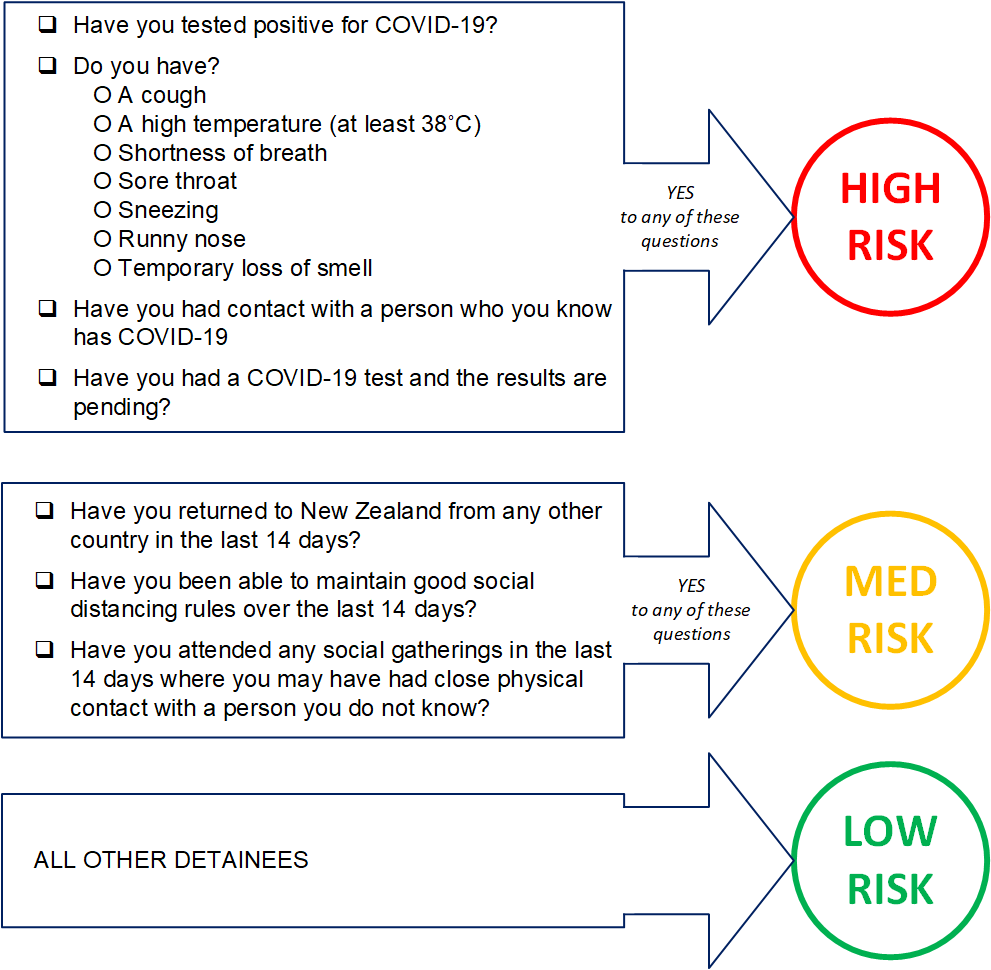 Appendix B: Guide to assessing the risk of COVID-19
GUIDELINES FOR ASSESSING
RISK OF COVID-19
Appendix B: Guide to assessing the risk of COVID-19
GUIDELINES FOR ASSESSING
RISK OF COVID-19
The questions below are to be considered when assessing the risk that a person
has COVID-19. Answers to these questions may be obtained by asking questions or
observing behaviours.
COVID-19 - Police Custody Operating Procedures - August 2020
Page 25
COVID-19 - Police Custody Operating Procedures - August 2020
Page 26
 COVID-19 quick advice:
“What do I do if someone spits or vomits on me?”
COVID-19 quick advice:
“What do I do if someone spits or vomits on me?”
This is a distressing event at any time, and more so in the current environment. However, at this point
in time community spread of COVID-19 in New Zealand is limited and the risk is still low.
Refer to the
note below for instructions on obtaining a tested individual’s COVID-19 status.
If you believe you are exposed to COVID-19 because someone spat or vomited on you, there are some
actions you can take immediately to assess your risk and minimise the likelihood you will contract the
virus. Please note that you will not be infectious immediately after exposure, as the virus hasn’t had
time to develop in your system, so there is time to assess your risk to others. Remain calm, and follow
these steps.
The Blood and Body Fluid Exposure (BBFE) guidelines and processes still apply:
https://tenone.police.govt.nz/pi/blood-and-body-fluid-exposure
Following the event:
1. Immediately wash away bodily fluids.
Spit to the open eyes and mouth is the main concern with COVID-19. If this happens,
immediately use normal post-BBFE first aid measures (irrigating with water/rinsing out mouth).
Body fluids contacting intact skin is low risk so long as good hygiene processes are followed:
o Wash or sanitise your hands and exposed skin where spit may be present
o Do not touch your face – especially your eyes, mouth and nose
o Wash or sanitise your hands after touching any contaminated items or surfaces including
clothing or PPE.
2. Remove contaminated clothing as soon as possible.
If you can do so safely and securely, remove any severely contaminated items of clothing and
put these into a plastic bag.
Use the Oxivir wipes to wipe off body fluids from your clothes and shoes if you can’t
immediately remove these items. Remember to sanitise your hands after doing this.
When you return to your station, go straight to the changing areas. Avoid stopping at
workstations or in common areas and keep your distance from other people until you can
remove your contaminated clothing.
Remove your contaminated clothing and put it into a plastic bag, then shower using warm water
and soap.
Guidelines on cleaning your uniform and body armour can be found on the TEN ONE COVID-19
page
s: https://tenone.police.govt.nz/page/health-hygiene
When you get home, put your uniform straight into the washing machine (washing your hands
again immediately afterwards). Do not mix contaminated clothing with any other laundry.
Throw the plastic bag away.
Assessing your risk following exposure:
If, during the incident, you were wearing appropriate PPE; the spit did not enter your nose, mouth,
eyes or broken skin; and you undertook immediate steps to limit any subsequent exposure by applying
good hygiene practices – you do not have to self-isolate even if the person is a confirmed COVID-19
case. However, monitor your health closely for 14 days and contact your GP immediately if symptoms
develop.
Most GPs/DHBs will not test you for COVID-19 unless you have symptoms.
If you think there is a risk of COVID-19 exposure, follow the guidelines for obtaining results for tested
individuals from Public Health:
https://tenone.police.govt.nz/media/13698. Public health should be able to tell you if the source is a suspected or confirmed case, or is awaiting
test results.
1. If you receive confirmation the person has tested positive for COVID-19, or is considered a probable
case, and you were not protected from exposure, self-isolation for 14 days is non-negotiable.
Contact your GP if you develop any symptoms.
2. If Public Health advises the source person is awaiting test results, self-isolate for 14 days unless a
negative swab result (from source) is received.
3. If the person has not been tested or has had a negative test result, and Public Health has no
concerns about the person, there is no need to self-isolate so long as you remain well. You should
still monitor your health over the next 14 days and have a low tolerance for the development of any
symptoms.
4. If you have any concerns about your health, contact your GP. They can give more specific advice.
NOTE: Obtaining the COVID-19 status for tested individuals
You can check someone’s COVID-19 status in NIA or contact your local Public Health Unit (PHU) if no
information is available.
See the guidelines for obtaining results for tested individuals for more information:
https://tenone.police.govt.nz/media/13698
link to page 49
 Personal Protective Equipment
Personal Protective Equipment
This document covers the selection and application of PPE for Police staff
How does COVID-19 spread?
COVID-19, like the flu, is spread from person to person through droplet transmission or contact
with surfaces droplets settle on. Droplets are generated when a person talks, coughs or
sneezes. These can be inhaled or absorbed by another person via the eyes nose and mouth.
These droplets can also settle onto surfaces, including skin or clothing, and transfer to another
person through contact if someone touches that surface then touches their face.
Basic principles
The basic principles for the prevention of COVID-19 spread under all alert levels are:
Frequent Hand hygiene – wash hands with soap for 20 seconds, rinse and dry
thoroughly, or sanitise
Physical distancing of at least 2 metres with anyone you don’t know
Physical barriers where available and appropriate
Safe cough/ sneeze etiquette – cough/sneeze into a tissue or your elbow
Good ventilation
The appropriate level of protection should be chosen for the degree of risk of infection remaining
after other control measures have been taken. Use TENR to assess risk of exposure to COVID-
19.
PPE
Staff must make themselves familiar with the guidelines on when, where and how to use the PPE
relevant to their role.
Videos on how to use the items in the PPE kit can be found here:
Using your PPE Kit
How to order PPE
PPE is provided for all Police Employees where it is required for work purposes.
Districts and Work Groups are supplied from the National Pandemic PPE Stores. In each District
there are PPE Leads. The PPE Leads are responsible for ensuring all Police employees domiciled
within their District (regardless of Work Group) have access to PPE.
The PPE Leads work across their districts, service centres and other work groups to keep records
of stock numbers and place orders when/where required.
Any queries regarding PPE should be addressed through your supervisor in the first
instance. A list of PPE leads is attached as
appendix 1.
Issue Date: 25 August 2020
What PPE should you use and when
The type of PPE required depends on your role, the alert level in place in your District, how physically close you get to other people, and the risk
the other person may have COVID-19.
Some roles and tasks will have specific (and higher level) PPE controls already in place (for example – custody units, sudden death
procedures, cleaning protocols, or Op MERCY). If a PPE protocol exists for the task you are undertaking, follow that protocol. Where this is not the case, use the table below to determine the PPE required and to assist your TENR assessment:
Role
Alert level 2
Alert Level 3 or 4
High risk COVID-19 locations,
activities, or situations, or where
there is a high likelihood of
potential contact with secretions
Frontline Staff (while
Where you are unable to maintain
Minimum at all times when deployed
Minimum:
deployed operationally)
more than 2 metres physical
operationally in public spaces or
N95 or P2 mask
distance from members of the
dealing with members of the public:
Gloves
public:
N95 or P2 mask
Gloves
Apply TENR where there is a high
Minimum:
likelihood of potential contact with
N95 or P2 mask
secretions and consider the following:
Gloves
Goggles/eye protection
Coveralls
Where you are unable to maintain
Minimum at all times when dealing
Minimum:
Other Police employees
more than 2 metres physical
with the public:
N95 or P2 mask
that interact with the
distance from members of the
N95 or P2 mask
Gloves
Public in their role but
public:
Gloves
would not normally get
Apply TENR where there is a high
within 2m (e.g. front
Apply TENR:
likelihood of potential contact with
counter staff)
N95 or P2 mask
secretions and consider the following:
Gloves
Goggles/eye protection
Coveralls
Issue Date: 25 August 2020
Role
Alert level 2
Alert Level 3 or 4
High risk COVID-19 locations,
activities, or situations, or where
there is a high likelihood of
potential contact with secretions
Police employees that
do Masks not required in the office
Masks not required in the office
N/A
not interact with the
however staff should wear face
unless physical distancing of at least
Public as part of their
coverings (surgical or fabric masks) 1m and strict work bubbles can not be
role (office employees,
in situations where physical
maintained. Where physical
comms etc.)
distancing of at least 2m is not
distancing can not be maintained,
possible (eg on public transport)
surgical masks to be available for staff
to use.
Refer to building procedures.
Prioritise physical distancing,
Refer to building procedures. Prioritise
hygiene and restricting movement
physical distancing, physical barriers,
between work bubbles.
hygiene and restricting movement
between work bubbles.
Under MOH guidelines, everyone
should wear face coverings (surgical
or fabric masks) when in public.
Non-Police employees
Apply TENR. Provide the person
If physical distancing can not be
N/A
entering our workspaces
with a surgical mask to wear if they
maintained, provide the other person
or in close contact with
are exhibiting symptoms.
with a surgical mask. Staff to wear
Police staff (eg during
N95 mask.
transport, giving
statements etc)
Issue Date: 25 August 2020

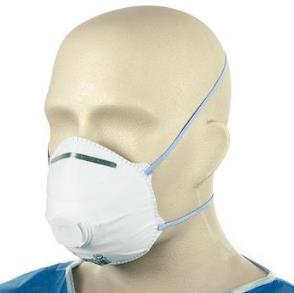

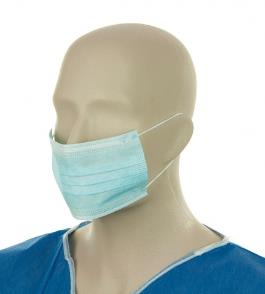
Masks
A range of masks offer protection to workers in medium to high risk situations. Across all types,
there are some basic principles to follow:
No mask is 100% effective.
Always follow basic hygiene and physical distance
principles.
To maximise the life of these masks, they need to be stored carefully to keep them clean.
All staff who might be required to wear a mask for protection must watch the attached
video on how to properly put on, fit test, and take off the mask.
Using your PPE Kit
If the mask has been worn in a situation where the mask may be contaminated, gets wet,
or looks dirty, replace the mask and dispose of it correctly.
Do not share masks.
Masks are meant to cover your mouth and nose. Do not pull the mask down to wear
under your chin or place on top of your head.
There are three main types of masks:
N95 or P2 (KN95/FFP2) masks:
The N95 or P2 rate respirator mask is a high specification, close fitting face mask for areas of
close contact and higher risk work. These masks provide the best protection to protect the
wearer from becoming infected, and from spreading diseases to others when properly worn. They are not
reusable.
Once these are in place, avoid touching the front of the mask. These can be used for up to 8
hours if kept dry and clean.
Disposable Surgical masks:
Designed primarily to contain droplet spread
from the wearer but do not provide much protection
to the wearer. These masks are not to be used by Police staff in circumstances where a member
of staff is wearing a mask for their personal protection (eg when dealing with the public) but they
can be worn by Police staff trying to reduce the general spread of infection.
Surgical type face masks reduce the likelihood that people who are infected with COVID-19 will
spread the disease to others in circumstances where other control mechanisms may not be
available or effective (such as physical barriers or physical distancing).
ISSUE DATE: 25 AUGUST 2020
 Fabric masks
Fabric masks:
These vary in effectiveness depending on a number of factors. These masks are intended to
minimise droplet spread from the wearer
but do not provide protection to the wearer. These are
fine for personal use but are not to be used for work purposes within Police where wearing a
mask has been mandated under these guidelines.
Facial Hair
In order for N95 masks to be effective, the wearer must be clean-shaven.
The protection from the mask is from a close airtight fit, this is unlikely to be achieved with facial
hair. Staff working in an environment where a N95 mask is required must remove their facial hair
if it is in the area where the mask contacts the skin.
If the employee refuses to remove their facial hair, or the facial hair is due to a religious or cultural
requirement, that employee must not be deployed into a high risk environment where a mask is
required.
Gloves
Gloves protect the wearer from contact with infectious particles. The wearer should take extra
care not to touch their face and other PPE whilst wearing gloves, as gloves are considered the
most contaminated item of PPE once they are worn. Gloves are not a substitute for hand hygiene.
If you are wearing gloves, discard and renew them between each contact with a potential COVID-
19 case.
Goggles/face shields
Goggles and face shields provide protection for eyes as the virus can be absorbed this way.
Goggles offer the best eye protection and are intended for use when there is a high likelihood the
officer may be exposed to airborne particles that may enter their eyes. They are re-usable and
should be cleaned with alcohol or antiseptic wipes after each use. Where fogging of goggles is an
issue anti-fogging solution, available from pharmacies, can be used to alleviate this problem.
Face shields and visors are less durable than goggles and are usually reserved for situations
where the sick person is compliant. A limited number of face shields are held nationally for
circumstances where goggles are completely unworkable. In these cases TENR must be applied
to assess the risks associated with using a face shield, e.g. no tight seal around eyes, risk of
shield being knocked off and/or used as a weapon when dealing with non-compliant people.
Coveralls
Coveralls are available for Districts to order and distribute as appropriate. The correct type for
most activities (not including specialist groups who will have their own protocols) are Cat III type 5
& 6 coveralls. Two types are available for order on SAP. Both are suitable.
Note, frontline staff must consider access to their appointments when using disposable coveralls.
PPE Disposal
PPE contaminated with confirmed or suspected COVID-19 should be disposed of as biohazard
waste. Alternatively it may be double bagged, the bags sealed by taping around the opening, and
left is a safe location for a minimum of three days (72 hours) prior to disposal, still double bagged
and sealed, in the general rubbish.
ISSUE DATE: 25 AUGUST 2020

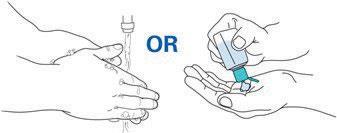



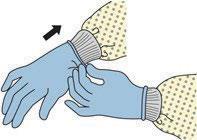
PUTTING ON AND TAKING OFF PPE
There is a correct sequence for putting on and taking off PPE to ensure the PPE remains
effective. Hand hygiene is a very important component of this process.
If you are not using a particular piece of equipment, skip that step and move on to the next.
SEQUENCE FOR PUTTING ON PPE
HAND HYGIENE
Wash hands or use an alcohol based
hand rub.
COVERALLS
Read instructions and put on coveralls.
If it has a hood,
do not raise the hood
yet.
MASK
Secure ties or elastic bands at middle of
head and neck, then fit the mask to your
face. Using both hands fit the metal
band on your nose.
For the N95 Mask a face fit test should
be completed. By placing your hands
lightly over the clean mask and
breathing in and out you will feel if any
air is escaping. If so, the mask is NOT
fitted correctly, and you should adjust
the nose band and straps to ensure a
close fit.
PROTECTIVE EYEWEAR OR FACE
SHIELD
Place over face and eyes and adjust to
fit (if you wear corrective lenses place
over these). If you have a hood on your
coveralls, you can raise it after this step
(note: the ties for the mask and goggles
must be
inside the hood).
GLOVES
Extend to cover wrist of coveralls
If you may have contact with body fluids,
blood, vomit etc. then
double glove, the
contaminated gloves can then be
removed without compromising your
PPE.
ISSUE DATE: 25 AUGUST 2020

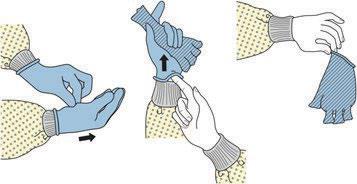
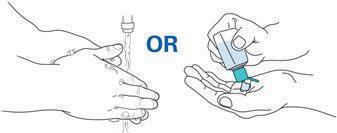
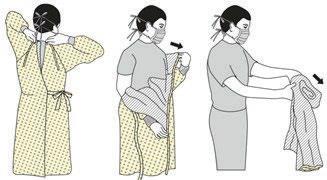
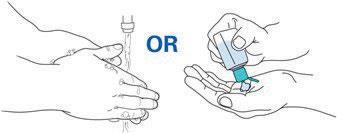

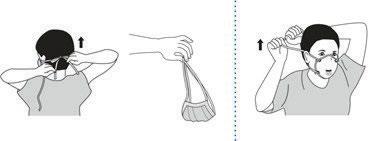
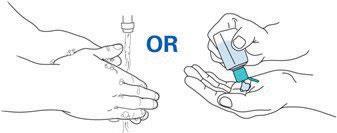
SEQUENCE FOR TAKING OFF PPE
GLOVES
The outside of gloves is highly contaminated!
Grasp outside of glove with opposite gloved
hand and peel off
Hold removed glove in gloved hand
Slide fingers of ungloved hand under
remaining glove at wrist.
Peel glove off over first glove
Discard gloves in designated waste
container.
HAND HYGIENE
Wash hands or use an alcohol based hand rub.
COVERALLS
The outside of the coveralls is contaminated.
Remove by rolling down and outwards and
pulling away from the neck and face. The
coveralls should end up inside out.
Roll into a bundle and discard in the designated
waste container.
HAND HYGIENE
Wash hands or use an alcohol based hand rub.
PROTECTIVE EYEWEAR OR FACE SHIELD
Avoid touching the front of the goggles.
Remove by grasping the handle or headband
and pull them away from your face. Clean with
an alcohol wipe or wash well with soap and
water.
MASK
Always remove your mask last! The front of the
mask is contaminated. DO NOT TOUCH IT.
Remove by grasping the ties/elastic and pull
over your head and away from your face.
Discard in the designated waste container.
HAND HYGIENE
Wash hands or use an alcohol based hand rub.
ISSUE DATE: 25 AUGUST 2020

APPENDIX 1
List of PPE Leads
Any queries regarding PPE should be addressed through your supervisor in the first
instance.
District
Primary contact
Secondary Contact
Northland
Murray Hodson
Tracy McCarthy
Waitemata
TM, John Bleackley
James Bothamley
Auckland City
Garry Ball
Pablo Miramontes
Counties Manukau
Mark Chivers
Samantha Vuleta
Waikato
Haydon Sievwright
Vince Ranger
BOP
Ed Van Den Broek
Jamie Keenleyside
Eastern
Angela Hallett
Martin Lawrence
Central
Christopher Day
Pete Thurston
Wellington
Lynne Adamson
Jen Blackwood
or email:
[email address]
Tasman
Martin Tunley
Malcolm York
Canterbury
Stefan Preddy
Peter McCarthy
Southern
Sam Ramsay
Mathew Scoles
PNHQ, (180 Molesworth
Wayne Kelman
St, Wellington only)
ISSUE DATE: 25 AUGUST 2020
 Frontline Staff – Protecting Family Members at
Frontline Staff – Protecting Family Members at
Home Frontline staff can take a number of simple hygiene steps to minimise the risk of
carrying disease to their home environment when returning home from work and keep
your home environment a safe and clean zone.
Hygiene Recommendations
Do:
Remove your uniform and boots at the station and change into civilian clothing
Keep your civilian clothing and footwear in a protective bag (plastic bag, sports
bag etc.) when stored in your locker
When taking your uniform home to launder place in a washable fabric bag (tight
weave fabric) or plastic bag
o Wash the carry bag with the uniform (or immediately dispose of plastic
bag)
o Do not shake clothes when placing in laundry
Place any work items (e.g. pens, keys) in a zip-lock bag if you need to take them
home
Keep personal items away from the work environment where possible
Decontaminate personal items taken into the work environment at the end of
your shift (e.g. glasses, wallet, cell phone)
If commuting in a shared family vehicle, sanitise the vehicle (e.g. wipe down
steering wheel, arm rest, door handles) on arrival home
If you have shower facilities at work:
Shower at work before changing into your civilian clothing (where shower
facilities exist at work)
o Consider washing your hair each time you shower
On arrival at home wash your hands before touching other surfaces or your
family members and pets
If you do not have shower facilities at work:
Remove your footwear before entering your home, and leave outside (e.g. place
in a plastic bin or plastic bag)
Remove your outer layer clothes on arrival home and place in the washing
machine
Shower at home before touching other surfaces or your with family members and
pets
o Consider washing your hair each time you shower
Do Not:
Take family members into your work environment
Remain in your uniform, or other potentially contaminated clothing, after arrival
home











































